The wellness kitchen was an emerging trend in kitchen design before the COVID pandemic. Now, several years post-COVID, the concept of the wellness kitchen has really taken off as homeowners’ attitudes, lifestyles, design preferences and purchasing decisions have been completely reshaped as a result of the COVID-19 pandemic.
What Is a “Wellness” Kitchen?

Kitchen design professionals report that the pandemic and a desire for one’s home to be a safe and healthy space has increased interest in ways to make a kitchen become a “wellness” kitchen. Accordingly, the kitchen should be flexible, efficient and adaptable for multitasking. Plus, it needs to function well and keep everyone safe.
It’s no longer good enough for kitchens to look nice, homeowners want them to help them feel good too. People have come to prioritize health and wellness, focusing on:
- regular exercise
- healthy eating
- adequate sleep
- stress management
- work life balance
- maintaining mental and emotional well-being
Homeowners are asking their designers what they can do to bring physical and mental health and well-being into their remodeled kitchens.
Wellness is a Priority
Recent surveys and reports, e.g., Kantar’s Americans at Home Study and The Global Wellness Institute in partnership with the National Academy of Sports Medicine, confirm that wellness, health and well-being are priorities for many homeowners. Kitchen designers can capitalize on the market demand for health and well-being solutions by emphasizing the benefits offered by specific products and solutions. Most homeowners do not realize these products exist.
Wellness comes with a language all its own that design professionals need to learn to meet the demands of a growing customer base. You need to understand product styles, finish options and performance capabilities of the products that contribute to making homes healthier and more enjoyable to use.
Where Did Wellness Design Come From?
Before COVID, the “green” movement of the early 2000s focused on avoiding toxic chemicals in the home and creating a healthy environment for people. Cabinet manufacturers got onboard by reducing or eliminating VOCs in their products, from plywood to finishing materials. (See #5 in the following list.)
What Does a Wellness Kitchen Include?
Many kitchen designers are incorporating wellness features into their designs, thanks to consumer demand. They report that their wellness kitchens include some or all of the following 13 items.
#1. Space for Socializing

Having the space to socialize, especially interacting with family, is an important part of a wellness kitchen design. Visiting with family and friends in one’s kitchen makes it possible to have fun and create memories that contribute to overall health and emotional well-being.
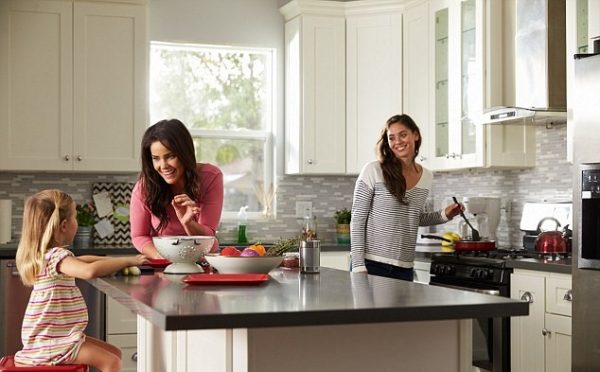
A large island is the perfect centerpiece of the social kitchen, with room for food prep, room for standing and moving around and room to sit and converse.
#2. Biophilia
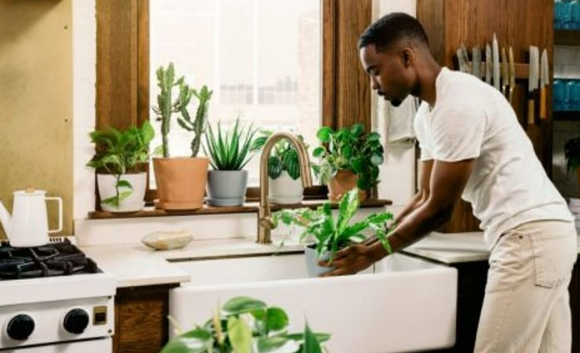
Now more than ever, homeowners want a connection to nature, both indoors and out. Bringing natural elements indoors is a growing trend. Also part of this trend is creating outdoor spaces that are functional havens for fresh air, exercise, relaxation and socializing.
Biophilia is defined as the human instinct to connect with nature and other living beings. The term comes from the Greek words for “life” and “love or affection.” Thus, its literal translation is “love of life.”
In our kitchen design world, biophilia is the term for incorporating nature and natural influences and materials into design. In the photo at right from Bloomscape, the young man is tenderly treating his plants to a drink in the kitchen sink.
It’s part of wellness design. Being in nature supports physical health and psychological well-being and helps to reduce stress and improve mood and creativity.
Plant walls and other green growing plants, skylights and large windows connect kitchens with nature and natural light.
However, bringing nature indoors is more than house plants. Materials found in nature, such as wood and stone, are environmentally friendly and satisfy the need to see natural materials in the kitchen.
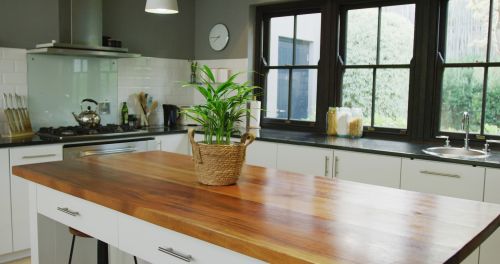
Include a Kitchen Garden
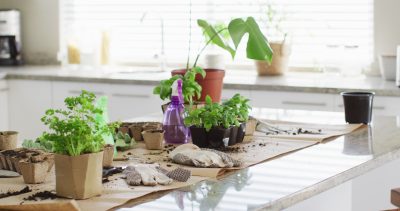
A kitchen garden from Power House Hydroponics demonstrates that growing one’s own food encourages healthy eating, adds oxygen to the air, reduces dependence on grocery stores and brings a sense of accomplishment to the gardener. Additionally, growing herbs on the windowsill does away with buying expensive small amounts in plastic boxes. Which are not recyclable, BTW.
Thanks to an increased focus on wellness, more options for indoor gardens are available. It has become easy to grow an indoor garden with LED lights and timers. The internet is filled with resources. The first result from Google is Gardeners.com that has an amazing selection.
#3. Universal Design
According to the World Health Organization, more than one billion people or about 15% of the global population, live with some type of disability. When the homeowners’ ages, heights and abilities are taken into consideration during the planning process, wellness is enhanced.
A few basic components to universal design include:
- non-skid floors
- raised height dishwashers so the top and bottom racks are at a comfortable height. The photo at left from X.com shows a raised dishwasher that just makes so much sense and eliminates the need for bending over to load and unload the dishwasher
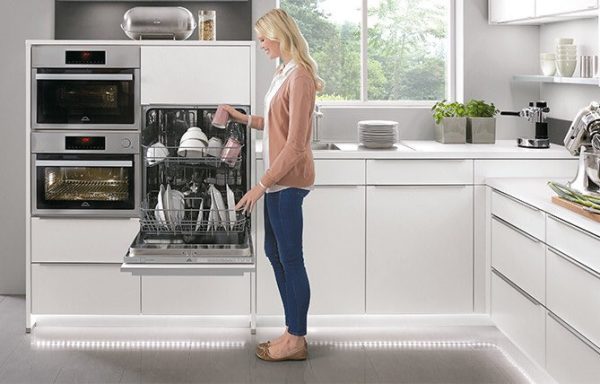
- Different seating heights at the island to accommodate all family members
- Deep drawers organized so that contents can be accessed easily and items removed efficiently.
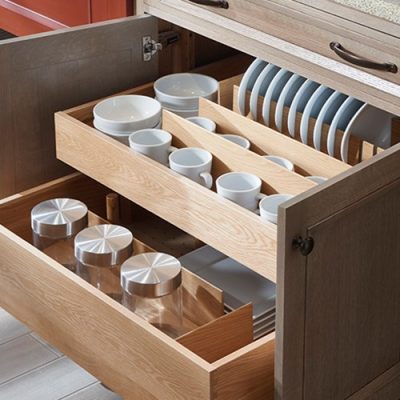
#4. De-clutter
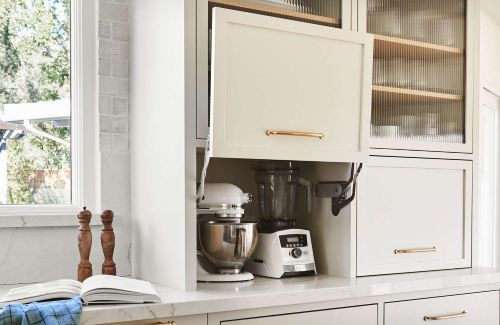
De-cluttering has a therapeutic effect, and thus is important for emotional wellbeing. Simple, clutter-free surfaces soothe the eyes and brain, and a sense of order and being able to find things reduces stress.
Therefore, a wellness kitchen design should include lots of in-cabinet storage to get clutter off countertops and into cabinets. An appliance garage, in-drawer storage, storage solutions for corner cabinets – all important to the wellness kitchen. The appliance garage shown here is one recommended by Martha Stewart.
#5. Non-toxic Materials
Experts recommend using cabinetry, paint and other materials with few or no volatile organic compounds (VOCs) or other noxious chemicals in a wellness kitchen.
#6. Ventilation
The integration of smart home technologies that monitor and improve air and water quality, regulate lighting, and control temperature is becoming more common. These advancements aim to create environments conducive to relaxation and health.
The wellness kitchen should include air purification products that minimize toxins, keep pollutants to a minimum and provide clean indoor air quality.
Designers can help by following the Public Health standards and choosing and specifying products that maintaining VOC limits, specifically for interior paints, coatings, adhesives, sealants, insulation and flooring.
Add a radon detector to warn about unsafe levels of radon (a major lung cancer risk), a carbon monoxide detector for each floor and working smoke detectors/alarms.
#7. Light
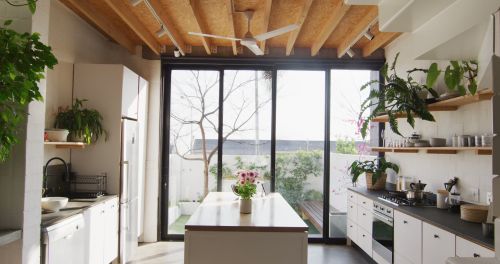
- Enlarging existing windows and/or adding new windows and skylights brings in natural light, which has proven health benefits:
- Increased productivity
- Improved mood
- Energy conservation
- Boosted physical, emotional and psychological wellbeing

To add to the natural light in a wellness kitchen, use LEDs. LED lighting is long lasting and energy friendly. Beyond that, LED lights can minimize seasonal affective disorder (SAD), which is definitely not healthy.
#8. Appliances
Today’s cooking appliances, such as steam ovens, sous vide and air fryers, offer healthier food prep options.
Induction cooktops replace gas cooking which has been proven to add pollutants (nitrogen dioxide, benzene, carbon monoxide and methane) to indoor air that can cause respiratory problems and increase the risk of heart disease. (Photo of induction cooktop from Real Simple.)
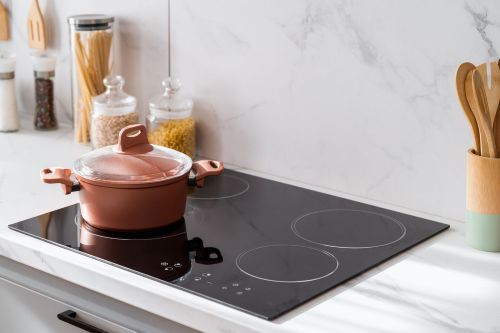
Dishwashers have high temperature sanitizing cycles.
In addition, no-touch faucets help prevent the spread of germs from dirty hands.
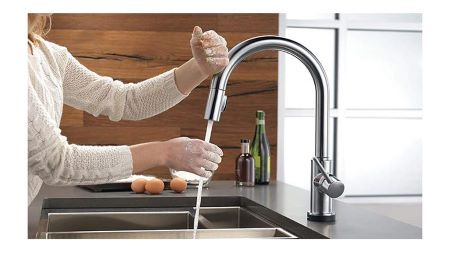
#9. Bacteria-Resistant Surfaces
The wellness kitchen requires easily disinfected surfaces. Products with antibacterial glazes can help reduce the amount of harmful bacteria in a kitchen. Behr even has a paint that kills bacteria.
#10. Color
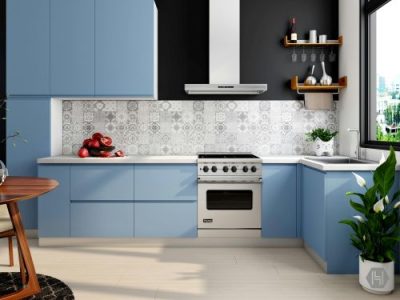
As designers, you don’t need to be reminded of the influence color has on a person’s mood. Now, the way colors are used in design has become a part of the wellness kitchen.
Certain colors and patterns affect the human brain, so using nature-inspired colors promotes calm and wellness
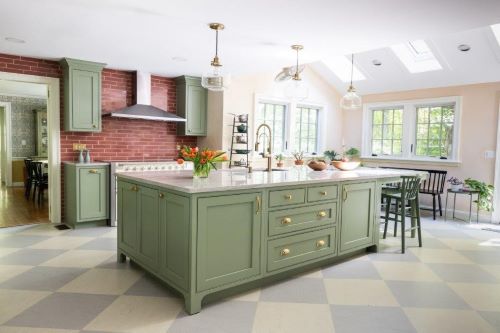
#11. Reduce Waste
In a wellness kitchen, food storage, preparation, cooking, consumption and disposal are all about fresh food and organic ingredients with a minimum of waste. Food from the grocery store comes wrapped in paper and plastic that adds to landfills.
Kitchens designed for wellness would include storage for foods that minimize waste. The slide-out baskets and storage inserts seen on Pinterest are examples of how fresh food can be stored in the wellness kitchen.
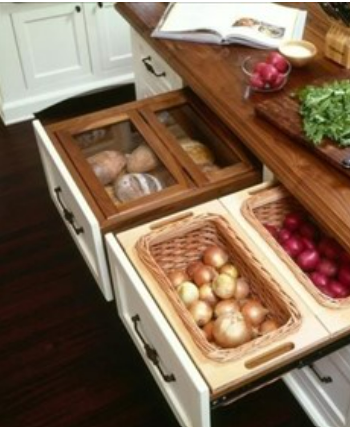
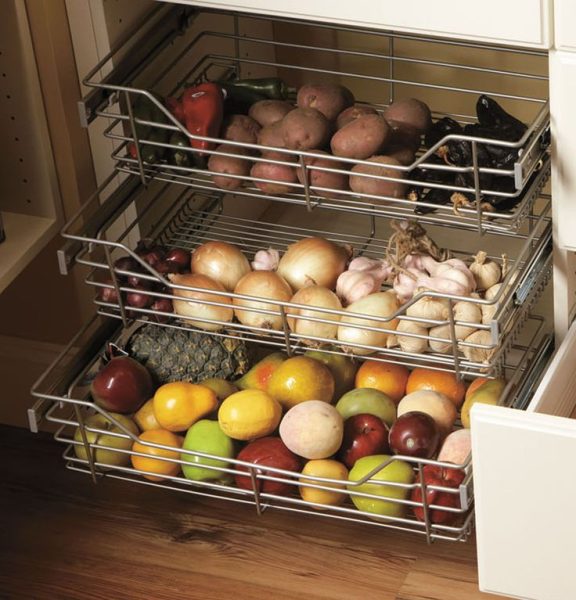
Homeowners interested in wellness design typically eat chemical- and preservative-free, locally sourced, fresh fruit and vegetables that require different food storage than what is found in a traditional kitchen.
In a wellness kitchen, fresh produce from local farms and home-grown produce has no packaging that goes into landfills.

Most traditional refrigerators, cabinets and pantries are designed to store pre-packaged foods. But fresh ingredients need to be stored to maintain freshness and nutritional value.
Conclusion
People looking for a new kitchen want one that isn’t simply functional, but one that makes it easier for them to follow a lifestyle that incorporates healthy eating and a commitment to eco-friendliness and healthy living. Wellness design is here to stay.
Bob Aungst Cabinet Sales is a full-service rep agency with the goal of matching kitchen designers and remodelers with the cabinet manufacturers best suited to their business’ style and clientele. Owner Bob Aungst III represents Brighton Cabinetry, US Cabinet Depot, Integrity Cabinets and StyleCraft Luxury Custom Cabinets.
